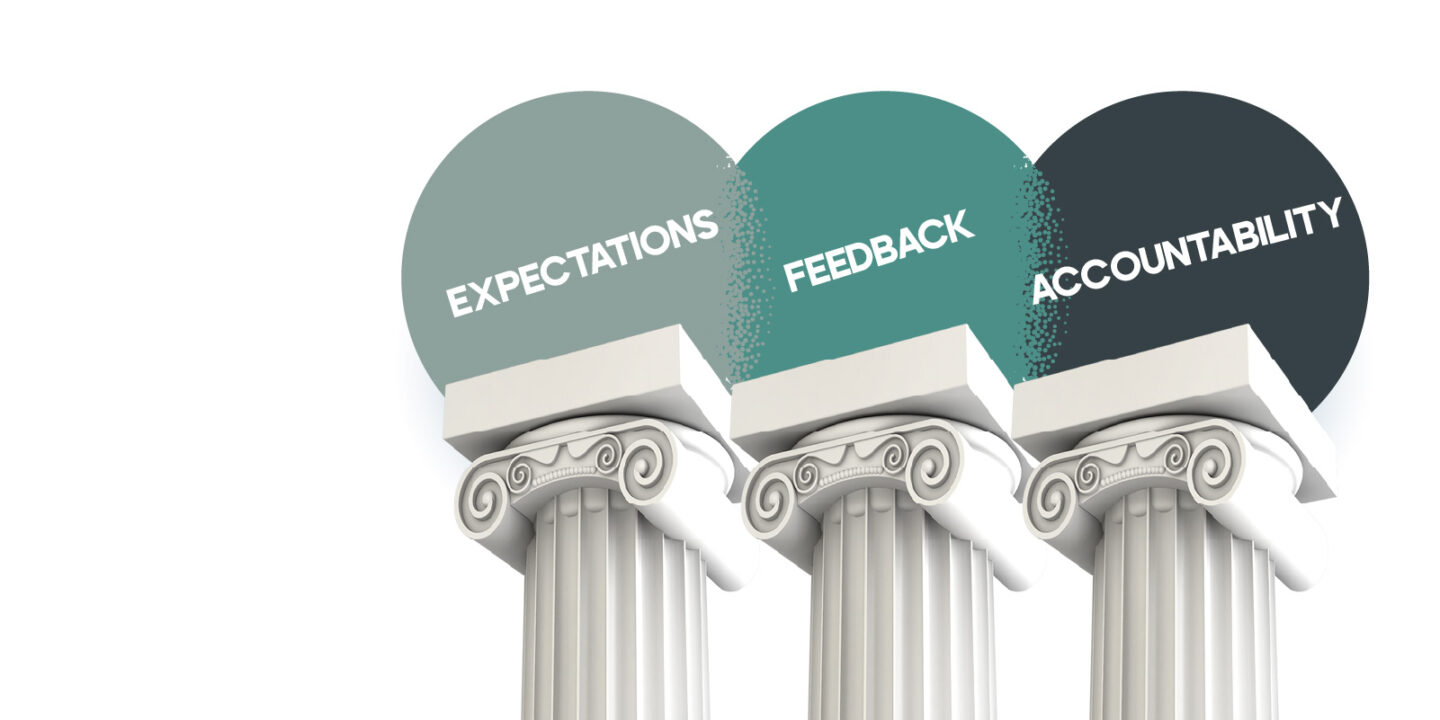
“We were so scared of our IPO”: Leaders Unplugged with former On-CEO Marc Maurer
Marc Maurer shares how ON grew from startup to IPO by defying hype, focusing on purpose, and leading with humility in this candid Leaders Unplugged episode....

by Jeff Hancher, Michael D. Watkins Published May 24, 2024 in Leadership • 11 min read
Effective performance management is more than a desirable goal – it’s an essential driver of organizational success. Leaders who neglect this crucial aspect of their role risk allowing poor performance to persist, eroding team morale, productivity, and their organization’s effectiveness.
Furthermore, when terminating underperforming employees, organizations that fail to implement a well-structured and documented performance management process could be exposed to potential legal action as well as potentially serious financial implications and other costs, such as a loss of focus on the part of the leader and the rest of the team.
Conversely, leaders who excel at performance management can reap substantial benefits. By fostering a culture of engagement, accountability, and continuous improvement, they unlock the full potential of their teams. Employees who clearly understand expectations and receive regular, constructive feedback are more motivated, productive, and committed to their roles.
To illustrate, let’s consider Sarah, a marketing manager at a tech startup who faced the challenge of managing an underperforming employee named Mark. Despite his initial enthusiasm and strong qualifications, Mark consistently missed deadlines and produced mediocre work. His poor performance negatively impacted the team, as other members couldn’t depend on his work and struggled to compensate.
How Sarah worked with Mark to improve his performance highlights the three key pillars of effective performance management: setting expectations, providing feedback, and holding employees accountable.

Setting clear expectations is the foundation of effective performance management. When leaders set clear expectations, they can hold their employees accountable and create a high-performance culture. Whenever possible, assigning metrics to goals allows for well-defined measurement standards, making it easier for employees to understand their progress.
The first step is to communicate expectations clearly and consistently to ensure understanding. This involves defining goals using a SMART (Specific, Measurable, Achievable, Relevant, and Time-bound) framework and securing agreement from the employee. Considering factors such as adequate training, potential obstacles, and the employee’s understanding of the importance of their role will ensure that expectations are reasonable and fair.
When setting expectations, consider the employee’s perspective on their achievability. This clarifies what needs to be done and demonstrates the leader’s commitment to the employee’s growth and development. When expectations are set collaboratively and with empathy, employees are more likely to embrace them and strive to meet or exceed them consistently. Engaging in a two-way dialogue to understand the employee’s concerns, questions, and potential barriers can help ensure the expectations are realistic and attainable. The conversation should also explore factors impacting the employee’s performance, such as personal challenges, skill gaps, or team dynamics.
Moreover, understanding the employee’s perspective allows leaders to tailor their approach. For example, if an employee expresses concerns about the timeline for completing a project, the leader can work with them to break down the project into smaller, more manageable milestones. By collaboratively addressing potential obstacles and creating a plan to overcome them, employees become empowered to take ownership of their performance and success.
Demonstrate empathy and genuine interest in their success by actively listening to the employee’s concerns. This approach fosters trust and open communication, making employees more likely to share their thoughts openly. Together, the leader and employee can identify any necessary support, resources, or accommodations to help the employee meet expectations.
In Sarah’s case, she recognized the need to address the issue with Mark head-on and scheduled a one-to-one meeting. She began the performance management process by clearly restating the expectations for Mark’s role, emphasizing the impact of his work on the team’s overall success. During the conversation, Sarah actively listened to Mark’s perspective on the expectations and any challenges he faced. By doing so, she laid the groundwork for a constructive discussion and ensured that Mark understood what was expected of him while feeling heard and supported.

“To maximize the impact of feedback, set clear goals and provide descriptions and definitions to ensure clarity.”
Providing regular, constructive feedback is essential for fostering employee growth and development. This sets employees up for continuous improvement by reinforcing positive behaviors and helps them to stay on track by redirecting behaviors that are undesirable.
Timeliness is critical, as waiting too long can diminish its relevance and impact. Giving feedback as soon as possible after observing the behavior or outcome allows the employee to connect the feedback to their actions, increasing the likelihood of retention and application.
Focus on specific behaviors rather than general comments about the person. By addressing observable actions, leaders can provide concrete guidance on what the employee should continue doing or change. This approach helps to depersonalize the feedback and maintains the employee’s dignity, making them more receptive to the message.
Balancing with positive and constructive feedback is another crucial aspect of effective performance management. Acknowledging positive contributions boosts morale, reinforces desired behaviors, and creates a more supportive work environment. When delivering constructive feedback, make a conscious effort to recognize and praise employees for their strengths and successes to frame it as an opportunity for growth and development rather than a criticism of the individual.
Another essential element is to engage the employee in a two-way dialogue. Ask open-ended questions to gain the employee’s perspective on their performance, challenges, and goals. Leaders foster a collaborative problem-solving approach by actively listening and showing genuine interest in the employee’s input to help identify the root causes of performance issues and encourage employees to take ownership of their development.
To maximize the impact of feedback, set clear goals and provide descriptions and definitions to ensure clarity. Periodic conversations about progress and support should be the norm, rather than reserving it for when something goes wrong or during annual performance reviews.
Despite the importance of feedback, many leaders avoid giving it due to fears of hurting the employee’s feelings, causing offense or disappointment, or even prompting them to quit. To overcome these challenges, leaders must be trained to understand their audience and use appropriate feedback techniques to achieve the best outcomes. This includes adapting their communication style to the individual, choosing the right time and place for the conversation, and maintaining a supportive and empathetic tone.
In the case of Sarah and Mark, Sarah provided specific examples of Mark’s recent performance, focusing on the gaps between expectations and his actual output. By maintaining a balanced, supportive tone and asking open-ended questions, she created an environment conducive to growth and improvement. Sarah actively listened to Mark’s concerns and worked with him to identify solutions and resources to help him succeed. By approaching the situation with empathy and a genuine desire to help Mark improve, Sarah demonstrated effective feedback techniques that fostered trust and collaboration.

“By asking the employee to consider the consequences of continued underperformance, the leader sets the stage for a collaborative discussion on the potential outcomes and the employee's role in determining their future with the organization.”
The final piece of the performance management puzzle is accountability. Holding employees accountable ensures that expectations are met, and feedback is acted upon, driving sustained success for both the individual and the organization.
When addressing accountability issues, ask five key questions to ensure a thorough understanding of the situation and to guide the employee toward improved performance.
“Do you know what the expectation is?”
This question helps determine whether the issue stems from a lack of understanding (can’t do) or a lack of willingness (won’t do). This distinction is crucial, as it informs the leader’s approach to resolving the problem.
“Can you tell me what the expectation is?”
This validates the employee’s understanding of the expectation. By having the employee articulate the expectation in their own words, the leader can identify any misinterpretations or gaps in understanding, allowing for clarification and realignment.
“Can you tell me why meeting or exceeding the expectation is good for you?”
This encourages the employee to consider the justification and purpose behind the expectation. By connecting the expectation to personal benefits, such as career growth, skill development, or increased job satisfaction, the leader helps the employee find intrinsic motivation to meet or exceed expectations.
“What behaviors will you change in the future to ensure that you meet or exceed expectations?”
This promotes buy-in from the employee. By identifying specific actions the employee will take to improve their performance, the leader encourages ownership and accountability for the desired outcome.
“If this behavior continues, what do you think we should do about it?”
This directly addresses accountability. By asking the employee to consider the consequences of continued underperformance, the leader sets the stage for a collaborative discussion on the potential outcomes and the employee’s role in determining their future with the organization. It is essential to end each accountability discussion by agreeing the next steps should the behavior not improve.

“Be prepared to address the consequences of continued underperformance.”
While the five questions above provide a solid foundation for addressing accountability issues, leaders may encounter various challenges when implementing this approach. One common challenge is dealing with emotional reactions or defensiveness.
Some employees may become upset, angry, or withdrawn when confronted about their underperformance. To handle these situations effectively, it’s important to remain calm, empathetic, and focused on the facts. Acknowledging the employee’s feelings while firmly reiterating the expectations and consequences can help diffuse emotional tensions and keep the conversation on track.
Another challenge arises when the causes of underperformance are unclear or complex. In such cases, dig deeper to uncover the root issues. This may involve asking additional questions, gathering input from colleagues or stakeholders, or reviewing relevant data and documentation. Approach these situations with an open mind and a willingness to explore multiple perspectives. By thoroughly understanding the factors contributing to underperformance, leaders can develop more targeted and effective solutions.
In some instances, employees may resist taking ownership of their performance issues, instead blaming external factors or other team members. To counter this, focus on the employee’s specific actions and behaviors rather than engaging in debates about external circumstances. Emphasizing the employee’s role in the situation and the steps they can take to improve reinforces the importance of personal accountability.
Be prepared to address the consequences of continued underperformance. This may involve progressive discipline, such as verbal warnings, written reprimands, or performance improvement plans. By clearly communicating the potential outcomes and following through consistently, leaders send a strong message about the importance of meeting expectations.
Strive to maintain a supportive and collaborative approach throughout the accountability process. Offering resources, training, or mentorship to help employees overcome challenges demonstrates the leader’s commitment to their success. Celebrating progress and recognizing improvements can further reinforce positive behaviors and boost motivation.
By systematically working through the five accountability questions and proactively addressing common challenges, leaders can foster a culture of ownership, responsibility, and continuous improvement. This approach ensures that expectations are met, feedback is acted upon, and employees are equipped to achieve sustained success in their roles, ultimately driving the organization forward.

The expectations-feedback-accountability framework offers a robust approach through which leaders can ensure their employees understand expectations, take ownership of their actions, and prepare for the consequences of continued underperformance.
However, it is essential to recognize that these three pillars are not meant to be one-off interventions but integral components of an ongoing performance management cycle. By regularly revisiting expectations, providing continuous feedback, and enforcing accountability, leaders can create a culture of excellence and continuous improvement.
Setting clear expectations should not be a singular event but an ongoing process. As business needs evolve and employees grow, periodically review and adjust expectations to ensure they remain relevant and challenging. This regular realignment keeps employees engaged and focused on the most critical priorities.
Similarly, feedback should be a continuous flow rather than sporadic events tied to annual reviews or performance issues. Prioritize frequent, informal check-ins to discuss progress, provide guidance, and recognize achievements. This ongoing dialogue helps employees stay on track, address challenges proactively, and feel valued for their contributions.
When performance issues arise, be prepared to enforce accountability through progressive discipline. If the situation persists, this may begin with informal coaching and escalate to more formal measures, such as written warnings or performance improvement plans. Leaders maintain fairness and minimize legal risks by consistently applying consequences and documenting the process.
However, accountability is not just about addressing underperformance; it also involves recognizing and rewarding exceptional work. Take the time to celebrate successes individually and at the team level. Public acknowledgment, meaningful rewards, and career development opportunities reinforce the behaviors and results that drive organizational success.
By clearly restating expectations, providing specific feedback, and developing an action plan together, Sarah successfully helped Mark improve his performance, ultimately strengthening the team’s overall effectiveness and morale. This approach paves the way for progressive discipline, if necessary, ensuring that termination, if it occurs, is not a surprise but rather a logical outcome. When both parties are on the same page, they can part ways on better terms, reducing the impact on others and the company’s liability.
Ultimately, the expectations-feedback-accountability framework is most effective when applied consistently over time. Sarah’s approach with Mark demonstrated that a well-executed performance management strategy can transform underperforming employees into valuable contributors, ultimately strengthening the organization.
In summary, effective performance management is both an art and a science. Leaders can create a culture of engagement, continuous improvement, and sustained success by mastering the three critical pillars of setting expectations, providing feedback, and holding employees accountable. By weaving these pillars into the organization’s culture and practices, leaders can drive sustained high performance and create an environment where employees thrive and excel.

President and Founder of Jeff Hancher Enterprises
Jeff is the President and Founder of Jeff Hancher Enterprises, a business consulting firm specializing in sales and leadership consulting, executive coaching, customized trainings, and keynote speaking. Prior to starting his own company, Jeff spent 24 years with the F500 company, Cintas Corporation. From humble beginnings as a truck driver, he was promoted ten times in his 24-year career with the company. Throughout his tenure with Cintas, Jeff earned numerous awards for his sales and leadership performance. While working in the corporate realm, Jeff discovered his passion for public speaking, as well as coaching and training leaders to reach their fullest potential. As an inventive and assertive leader, Jeff is constantly looking for ways to create sustainable growth for the organizations he works with. In addition to his work completed at Cintas Corporation, Jeff is also a veteran of the United States Army and the host of the award-winning leadership podcast, The Champion Forum Podcast. However, his favorite titles are that of husband to his wife, Janelle, and dad to his children, Jake, and Jacqueline.

Professor of Leadership and Organizational Change at IMD
Michael D Watkins is Professor of Leadership and Organizational Change at IMD, and author of The First 90 Days, Master Your Next Move, Predictable Surprises, and 12 other books on leadership and negotiation. His book, The Six Disciplines of Strategic Thinking, explores how executives can learn to think strategically and lead their organizations into the future. A Thinkers 50-ranked management influencer and recognized expert in his field, his work features in HBR Guides and HBR’s 10 Must Reads on leadership, teams, strategic initiatives, and new managers. Over the past 20 years, he has used his First 90 Days® methodology to help leaders make successful transitions, both in his teaching at IMD, INSEAD, and Harvard Business School, where he gained his PhD in decision sciences, as well as through his private consultancy practice Genesis Advisers. At IMD, he directs the First 90 Days open program for leaders taking on challenging new roles and co-directs the Transition to Business Leadership (TBL) executive program for future enterprise leaders, as well as the Program for Executive Development.

July 8, 2025 • by Alyson Meister, Marc Maurer in Leadership
Marc Maurer shares how ON grew from startup to IPO by defying hype, focusing on purpose, and leading with humility in this candid Leaders Unplugged episode....

July 7, 2025 • by Richard Baldwin in Leadership
The mid-year economic outlook: How to read the first two quarters of Trump...

July 4, 2025 • by Arturo Pasquel in Leadership
Susanne Hundsbæk-Pedersen, Global Head of Pharma Technical Operations at Roche, shares how she has navigated the various pivots in her career, and the importance of curiosity, optimism and energy. ...

July 3, 2025 • by Eric Quintane in Leadership
Entrepreneurial talent who work with other teams often run into trouble with their managers. Here are ways to get the most out of your ‘boundary spanners’...
 Audio available
Audio availableExplore first person business intelligence from top minds curated for a global executive audience